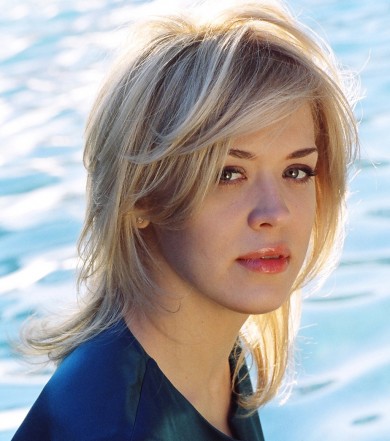Kern brings Romantic Russian flair to overflow crowd at Gusman

About 70 extra chairs were set up at the University of Miami’s Gusman Hall to accommodate the crowd – the biggest ever seen at a Sunday Afternoons of Music event. There were multiple standing ovations and three encores, as the glamorous Russian pianist Olga Kern played a recital of Romantic blockbusters, delivered with floor-shaking power, poetry and respect for the composers’ intentions.
Kern, the first woman to take the gold medal in the Van Cliburn International Piano Competition, has fashioned a career as a touring and recording virtuoso specializing in the works of Liszt, Chopin and Rachmaninoff.
You would expect a pianist of her tastes to play with thundering bravura, and she did Sunday in Chopin’s Sonata No. 2, Rachmaninoff’s Sonata No. 2 and Liszt’s Hungarian Rhapsody No. 2. But Kern is not a showboat attempting to get by on speed and volume. Just as impressive as her virtuosity was the poetry and sensitivity she brought to these works.
In the first movement of the Chopin sonata, after playing and developing the first theme in the huge tone she could draw from the piano, she came back to it quietly as an echo, playing it with a poignant tone that sounded as if it came from a different instrument — say a light-action Mozart-era fortepiano. In the third movement, the famous funeral march, she drew out a sustained crescendo of immense force, leading up to a fortissimo statement of orchestral grandeur without a trace of banging.
Kern has made a specialty of Rachmaninoff, and her performance of the composer’s Sonata No. 2 was powerful without the shapelessness that often afflicts this piece. There was an element of restraint to her playing, and unlike some pianists with an affinity for this repertoire, she resisted the urge to make every phrase a personal statement, showing respect for the music as written. In the second movement, she played the long, mournful melody, with its strange, dissonant harmonies, with a singing legato and another impressively smooth and sustained crescendo.
Piano recitals often begin with something by Haydn or Mozart, in a nod to the classical era before the 19th and 20th century works at the heart of the program, and Kern followed this tradition with Haydn’s Sonata in C Major, H. XVI: 50. But no one had really shown up that day for a Haydn sonata, including, apparently, Kern, who took an almost casual approach to the work, with an absence of the articulation, precision and commitment she displayed in the much more difficult pieces that followed.
Kern’s keyboard manner is distinctive. Upon hitting the last note of a roaring work like the Rachmaninoff sonata, she leaps from the bench and is bowing to the audience before the last note has died out. Kern has also developed a way of preventing inter-movement applause that turned out to be 100 percent effective, keeping her hands above the keyboard after hitting the last notes of a movement and shifting them to where they needed to be to begin the next movement.
The Liszt Hungarian Rhapsody, which had a cadenza by Rachmaninoff, allowed her to show off her technique, if that was necessary by then, and made a decent bonbon for the end of the recital.
As her first encore, she played The Spinning Wheel, a melody accompanied by rapid ornamentations that moved from hand to hand, by the little-known Swiss composer Charles Lisberg, which she described to the audience — in clear English with an agreeable Russian accent —- as a favorite of her 11-year-old son. She followed with two more difficult virtuoso works, Rachmaninoff’s Moments Musicaux No. 4, and Moritz Moszkowski’s Sparkles.
Posted in Performances
Leave a Comment
Sun Mar 21, 2010
at 10:32 pm
No Comments